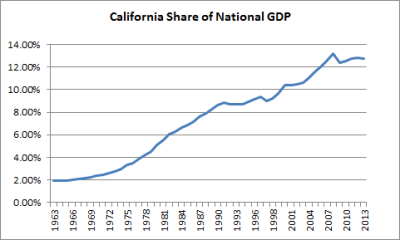Alex Tabarrok has written a series of posts over at Marginal Revolution (see here and here) on California’s water shortage and how it should be resolved. Alex has portrayed California and San Diego in a particularly bad light that reminds me of many of the usual California stereotypes (inefficient, unproductive surf bums). I live in Encinitas, California which is a part of San Diego county. It’s a surf town, but it’s also a big farming town. In fact, I live on an old avocado farm. I own chickens and grow a lot of my own vegetables. I’m not a real farmer, but I produce a lot of what I consume. The primary cost in that production is water.
The funny thing about many of these stereotypes is that California produces an outrageous amount of what this country consumes. It’s particularly glaring when we look at agriculture. Let’s look at some of the figures.
As a share of national GDP, California is a behemoth. We produce almost 13% of the entire country’s output. At 2 trillion dollars we’re the 9th largest economy in the entire world. We produce more than India, Russia, Canada, Australia, Spain, Mexico, etc. And our output is becoming an increasingly important part of the nation’s overall output.
Given that this post was inspired by an agriculture post I won’t even touch on the fact that California has become the center of the technological world (that little place up north called Silicon Valley). There is a sound argument to be made that California is not just the most important technological producer in the world but is also the most important region of overall output that exists on Earth.
So, let’s ignore the great technologies that come from California and just focus on our farming and the sheer dominance of California in terms of its impact on agriculture. According to the 2013 Agricultural Statistic Review the state of California produces:
- 99% of the USA’s artichokes.
- 96% of the USA’s broccoli.
- 86% of the USA’s carrots.
- 95% of the USA’s celery.
- 86% of the USA’s leaf lettuce.
- 75% of the USA’s head lettuce.
You get the point. The state of California doesn’t just dominate much of US agriculture. It virtually IS agriculture in the USA. Much like Saudi Arabia is the monopoly supplier of oil to the world, the state of California is the monopoly supplier of agriculture to the USA. Tabarrok cites a misleading point that “Agriculture accounts for 80% of water consumption in California, for example, but only 2% of economic activity.” But that 80% of water is not only feeding tremendous demand for foreign food consumption. It’s feeding over 85% of much of the USA’s most essential agriculture. Tabarrok wants to paint California’s farms as unproductive and inefficient, but when placed in the proper perspective it’s clear that California’s farms, while probably imperfect, are highly productive.
Tabarrok then dismisses California’s water shortage as a purely economic problem that can be solved by raising prices and letting more farms fail. But as the monopoly provider of so much of the USA’s agriculture the story isn’t quite so simple. If the price of water rises substantially Tabarrok is right that many more farms would go under. And that, of course means far less supply of agriculture for the rest of the country (and the world) to consume. Assuming demand remains the same (or rises, as it has for fresh agriculture in recent decades) this means prices for agriculture will likely rise as a result of California’s water shortage and the recommended water price increase. This isn’t just bad for the farms and workers in California. It’s bad for the whole country.
The impact of California’s water shortage is much broader than just supply and demand inside California. The USA needs to move towards agricultural independence from the state of California. And that’s a problem that can’t be solved with short-term price increases in key cost inputs. In fact, given the obvious climate advantage California benefits from, it might not be a problem that can be easily solved by anyone other than California. And raising water prices just means the rest of the country needs to accept the simple reality that higher costs for California farmers will mean higher costs for the average American’s dinner. So we might want to be careful about implementing near sighted solutions to long-term problems.
Mr. Roche is the Founder and Chief Investment Officer of Discipline Funds.Discipline Funds is a low fee financial advisory firm with a focus on helping people be more disciplined with their finances.
He is also the author of Pragmatic Capitalism: What Every Investor Needs to Understand About Money and Finance, Understanding the Modern Monetary System and Understanding Modern Portfolio Construction.

